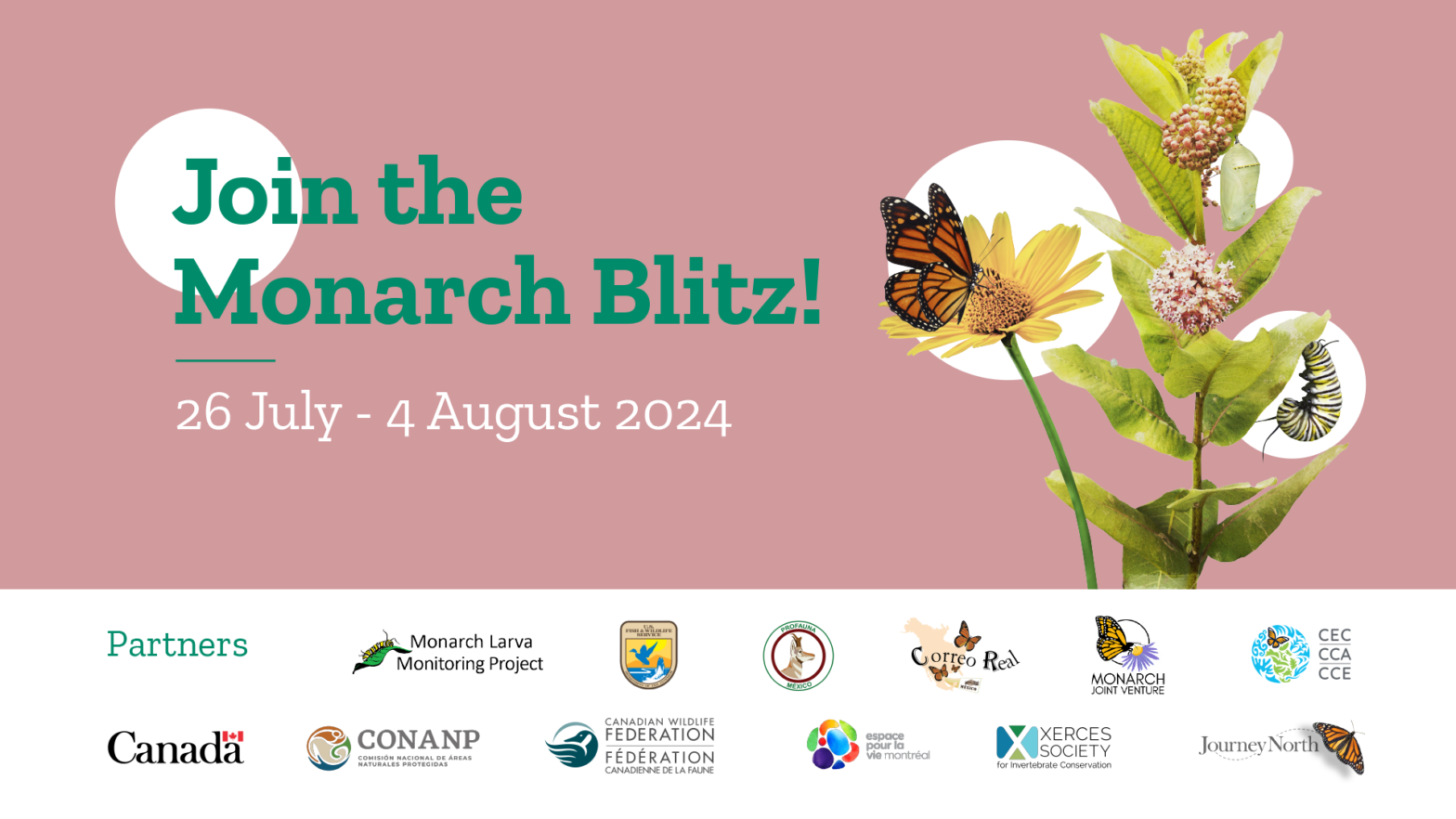Help Raise Awareness and Support Monarch Butterfly Conservation: Join the 2024 Monarch Blitz, 26 July–4 August!
Tiohtià:ke (Montreal), 9 July 2024 —The International Monarch Monitoring Blitz is back for its eighth edition from 26 July to 4 August 2024! The Blitz provides a unique opportunity for individuals and organizations in Canada, Mexico and the United States to join forces across international borders to safeguard this iconic North American species.
Since monarch butterflies and milkweed populations cover such an extensive portion of North America, the participation of volunteer community scientists is key for furthering our understanding of these species. In the context of climate change, the range of monarchs and milkweed is likely to be impacted, highlighting the need for gathering and analyzing robust, long-term data in order to better understand population and habitat trends.
For the 10-day period, the Monarch Blitz invites people from across North America to report monarch butterfly sightings, to find milkweed plants, and look for monarch eggs, caterpillars and chrysalises. To take part, simply go outdoors and share your monarch and milkweed observations with one of the participating community science programs indicated below.
Last year, close to 4,000 observations were collected, raising awareness about monarch conservation and collecting valuable breeding productivity data across North America. In fact, observations submitted by volunteers help identify priority areas for monarch conservation and guide conservation actions. The data collected during the Blitz will be made available for anyone to download and consult via the Trinational Monarch Knowledge Network, which features data from various sources and helps researchers perform large-scale analyses considering time and space.
This year, we are proud to announce that the Canadian Wildlife Federation, the lead organization for iNaturalist.ca, part of the global iNaturalist data-sharing platform, joined the group of international partners that help organize and promote the Monarch Blitz across North America.
The Blitz is the only coordinated North America-wide effort to capture a snapshot of the monarch and milkweed summer distribution. This information is crucial to help the scientific community understand and measure the reproductive success of the monarch breeding population as well as long-term population trends. This information is particularly important right now, given that the eastern migratory monarch population was at the second-lowest level ever observed in Mexico, covering an area of 0.90 hectares according to Conanp. This low population size is a stark reminder that North America has to continue to conserve and restore monarch butterfly breeding and migratory habitat to ensure the long-term health of the species.
In December 2023, the monarch butterfly officially received a designation as endangered under Canada’s Species at Risk Act.
“Participating in the International Monarch Monitoring Blitz is a concrete way to contribute to the conservation of this iconic butterfly. By joining thousands of volunteers across North America, you'll help gather crucial data on monarch populations and milkweed plants. This information allows conservation efforts to be targeted where they are most needed. By documenting monarchs and their breeding habitats for ten days, you'll be taking part in a valuable scientific initiative that strengthens the links between you and researchers, while contributing directly to the protection of biodiversity,” explained Maxim Larrivée, director of the Insectarium | Montréal Space for life.
In Mexico, the monarch butterfly is officially listed as a species at risk under Norma Oficial Mexicana 059 since 2010.
"The International Monarch Monitoring Blitz will be very important this year, because it will represent an opportunity to make an urgent call to the whole of society, governments and the private sector to work together to save the migratory monarch butterfly in North America. We are sure that if we join forces, work collaboratively and have societal participation in trinational initiatives like these as a foundation, we will achieve this objective," said Jerónimo Chávez, Project Manager of the Correo Real Program at Profauna, A.C.
In the United States, the U.S. Fish and Wildlife Service (USFWS) determined that listing the monarch butterfly as an Endangered or Threatened species was warranted, but was precluded by higher-priority listing actions. According to Mara Koenig, a Public Affairs Specialist at USFWS, a settlement agreement requires the agency to submit a proposed rule to list the monarch, if still warranted, to the Federal Register by 4 December 2024.
Wendy Caldwell, Executive Director of the Monarch Joint Venture, shared her thoughts regarding their participation in this collaborative effort:
"The Blitz brings together thousands of community scientists from all across North America to gather invaluable data on monarch butterflies. As an organization leveraging the power of people and partnerships, the Monarch Joint Venture is proud to be a member of this unique collaborative conservation project", Caldwell said.
With the conservation of the monarch butterfly gaining momentum across North America, now is the time for communities to go out into nature and take part in this initiative!
To take part in the Monarch Blitz, please share your observations through one of the participating community science programs below:
- Canada:
- Mexico:
- United States:
Follow the Monarch Blitz and share your participation in this international conservation effort on social media by using the hashtag #MonarchBlitz!
The Blitz is organized by the Trinational Monarch Conservation Science Partnership, a collaboration of organizations, including the Commission for Environmental Cooperation (CEC), the Comisión Nacional de Áreas Naturales Protegidas (Conanp) in Mexico, Environment and Climate Change Canada (ECCC), Insectarium | Montréal Space for Life, the Canadian Wildlife Federation, Journey North, the Monarch Joint Venture, PROFAUNA A.C., the U.S. Fish and Wildlife Service and the Xerces Society for Invertebrate Conservation.
Learn more about what we accomplished together last year and how you can get involved here on our website.
If you would like to know more about CEC initiatives, opportunities and efforts, you can sign up for our newsletter and follow us on social media.
